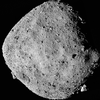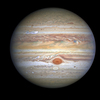New analysis has found a source of carbon within Europa, Jupiter’s moon that is believed to hold massive amounts of liquid water. This view of the moon was created from images taken by NASA’s Galileo spacecraft in the late 1990s.
NASA/JPL-Caltech
hide caption
toggle caption
NASA/JPL-Caltech


New analysis has found a source of carbon within Europa, Jupiter’s moon that is believed to hold massive amounts of liquid water. This view of the moon was created from images taken by NASA’s Galileo spacecraft in the late 1990s.
NASA/JPL-Caltech
In an intriguing breakthrough, astronomers have concluded that carbon, an essential component of life on Earth, is also present within Europa, Jupiter’s ice-covered moon that’s believed to hold huge oceans of liquid salt water beneath its icy surface.
The findings come from analyzing images from NASA’s James Webb Space Telescope, which found the carbon “likely originated in the subsurface ocean,” according to a summary of two papers about the analysis.
“The discovery signals a potentially habitable environment in the ocean of Europa,” according to the Webb telescope’s website.
Signs that a building block of life is in Europa’s ocean
Scientists had previously detected solid carbon dioxide on Europa’s surface, but they weren’t certain whether it might have come from off-moon sources, such as meteorites. The new research points to an answer — and to more questions.
“On Earth, life likes chemical diversity — the more diversity, the better. We’re carbon-based life. Understanding the chemistry of Europa’s ocean will help us determine whether it’s hostile to life as we know it, or if it might be a good place for life,” Geronimo Villanueva, lead author of one of two papers about the research, said as the findings were released. Villanueva is a planetary scientist at NASA’s Goddard Space Flight Center in Greenbelt, Md.
On the icy crust of Jupiter’s moon Europa, Webb has discovered carbon dioxide that likely originated in the liquid water ocean below. Understanding the chemistry of this ocean could help determine if it is a good place for life as we know it: https://t.co/tGLrJrVsyl pic.twitter.com/4C4JjZMCBw
— NASA Webb Telescope (@NASAWebb) September 21, 2023
“We now think that we have observational evidence that the carbon we see on Europa’s surface came from the ocean. That’s not a trivial thing. Carbon is a biologically essential element,” said Samantha Trumbo of Cornell University, who is the lead author of the second paper about carbon on Europa.
Much of the carbon dioxide was found in a region called Tara Regio, where sodium chloride — a.k.a. table salt — was spotted several years ago. Its name comes from Celtic mythology, signifying “the main royal residence of the High Kings.” But planetary scientists know the region as “chaos terrain,” where the landscape looks to be shattered, possibly from interactions between the icy surface and the ocean that is believed to lie beneath it.
No, it’s not time to meet the new neighbors




An image of Europa’s surface shows a region of “chaos terrain,” where the surface has broken apart into many smaller chaos blocks that are surrounded by a featureless matrix material.
It’s important to remember that in this context, a “habitable environment” on Europa refers to a salty ocean encased by an ice shell that’s believed to be 10 to 15 miles thick, on a moon where the sunlight is about 25 times fainter than on Earth.
If that’s not enough to make you put away your swimsuit, consider the neighborhood bully: Europa is under the thrall of Jupiter’s radiation and gravity — the latter is so strong, it’s believed to create tides that rip the moon’s thick ice crust apart.
But NASA says tidal flexing on Europa could also produce the heat and nutrients that encourage life. So while the differences between conditions on Earth are stark, similarities, like the likely presence of carbon, are compelling. And while Europa is a bit smaller than our Moon, its ocean is estimated to hold more than twice as much water as all of Earth’s oceans together.
The new findings come a year before NASA’s ambitious Europa Clipper mission, which will launch in October of 2024 and reach the Jovian moon in 2030.
Europa Clipper is set to be the largest spacecraft NASA has ever developed for such a mission, mainly because it needs large solar panels to operate that far from the sun. The craft will make nearly 50 flybys of Europa, as close as 16 miles from the surface.
This story originally appeared on NPR



